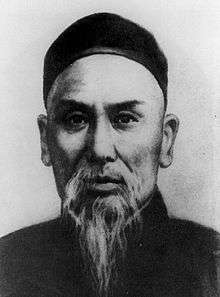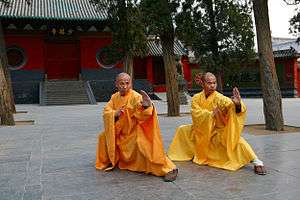Yang Luchan
Yang Lu-ch'an or Yang Luchan, also known as Yang Fu-k'ui or Yang Fukui (1799–1872), born in Kuang-p'ing (Guangping), was an influential teacher of the internal style martial art t'ai chi ch'uan (taijiquan) in China during the second half of the 19th century. He is known as the founder of Yang-style t'ai chi ch'uan, the most popular and widely practised style in the world today.[1][2]
| Yang Luchan | |
|---|---|
 | |
| Born | 1799 Guangping, China |
| Died | 1872 (aged 72–73) |
| Native name | 杨露禅 |
| Other names | Yang Fukui, Yang Wudi |
| Nationality | Chinese |
| Style | Yang-style taijiquan |
| Teacher(s) | Chen Changxing |
| Rank | Founder of Yang-style taijiquan |
| Notable students | Yang Banhou, Yang Jianhou, Wu Yuxiang, Wu Quanyou |
| Yang Luchan | |||||||||
|---|---|---|---|---|---|---|---|---|---|
| Traditional Chinese | 楊露禪 | ||||||||
| Simplified Chinese | 杨露禅 | ||||||||
| |||||||||
| Yang Fukui | |||||||||
| Traditional Chinese | 楊福魁 | ||||||||
| Simplified Chinese | 杨福魁 | ||||||||
| |||||||||
| Yang Wudi | |||||||||
| Traditional Chinese | 楊無敵 | ||||||||
| Literal meaning | Yang the Invincible | ||||||||
| |||||||||
| Part of a series on |
| Chinese martial arts (Wushu) |
|---|
 |
| Wushu in the world |
|
Historical locations
|
| Wushu athletes/practitioners |
|
Legendary figures
|
|
Historical individuals
|
|
Modern celebrities
|
| Wushu influence |
History
Yang Lu-ch'an’s family was a poor farming/worker class from Hebei Province, Guangping Prefecture, Yongnian County. Yang would follow his father in planting the fields and, as a teenager, held temporary jobs. One period of temporary work was spent doing odd jobs at the Tai He Tang Chinese pharmacy located in the west part of Yongnian City, opened by Chen De Hu of the Chen Village in Henan Province, Huaiqing Prefecture, Wenxian County. As a child, Yang liked martial arts and studied Changquan, gaining a certain level of skill.
One day Yang reportedly witnessed one of the partners of the pharmacy utilizing a style of martial art that he had never before seen to easily subdue a group of would-be thieves. Because of this, Yang requested to study with the pharmacy's owner, Chen De Hu. Chen referred Yang to the Chen Village to seek out his own teacher—the 14th generation of the Chen Family, Ch'en Chang-hsing.[1][2]
One night, he was awakened by the sounds of "Hen" (哼) and "Ha" (哈) in the distance. He got up and traced the sound to an old building. Peeking through the broken wall, he saw his master Chen, Chang-xing teaching the techniques of grasp, control, and emitting jin in coordination with the sounds "Hen" and "Ha." He was amazed by the techniques and from that time on, unknown to master Chen, he continued to watch this secret practice session every night. He would then return to his room to ponder and study. Because of this, his martial ability advanced rapidly. One day, Chen ordered him to spar with the other disciples. To his surprise, none of the other students could defeat him. Chen realized that Yang had great potential and after that taught him the secrets sincerely.[3][4]
After mastering the martial art, Yang Lu-ch'an was subsequently given permission by his teacher to go to Beijing and teach his own students, including Wu Yu-hsiang and his brothers, who were officials in the Imperial Qing dynasty bureaucracy.[2] In 1850, Yang was hired by the Imperial family to teach Taijiquan to them and several of their élite Manchu Imperial Guards Brigade units in Beijing's Forbidden City. Among this group was Yang's best known non-family student, Wu Quanyou.[5] This was the beginning of the spread of Taijiquan from the family art of a small village in central China to an international phenomenon. [6] Due to his influence and the number of teachers he trained, including his own descendants, Yang is directly acknowledged by 4 of the 5 Taijiquan families as having transmitted the art to them.[1][2][6]
The Legend of Yang Wudi
After emerging from Chenjiagou, Yang became famous for never losing a match and never seriously injuring his opponents. Having refined his martial skill to an extremely high level, Yang Lu-ch'an came to be known as Yang Wudi (楊無敵, Yang the Invincible). In time, many legends sprang up around Yang's martial prowess. These legends would serve to inform various biographical books and movies. Though not independently verifiable, several noteworthy episodes are worth mentioning to illustrate the Yang Wudi character:
- The House of Prince Duan, one of the royal families in the capital, employed a large number of boxing masters and wrestlers—some of which were anxious to have a trial of strength with Yang Lu-ch'an. Yang typically declined their challenges. One day, a famous boxing master of high prestige insisted on competing with Yang to see who was the stronger. The boxer suggested that they sit on two chairs and pit their right fists against each other. Yang Luchan had no choice but to agree. Shortly after the contest began, Duan's boxing master started to sweat all over and his chair creaked as if it were going to fall apart; Yang however looked as composed and serene as ever. Finally rising, Yang gently commented to the onlookers: "The Master's skill is indeed superb, only his chair is not as firmly made as mine." The other master was so moved by Yang's modesty that he never failed to praise his exemplary conduct and unmatched martial skill.[7]
- Once while fishing at a lake, two other martial artists hoped to push Yang in the water and ruin his reputation. Yang, sensing the attacker's intention, arched his chest, rounded his back, and executed the High Pat on Horse technique. As his back arched and head bowed, the two attackers were bounced into the water simultaneously. He then said to them that he would be easy on them today; but if they were on the ground, he would have punished them more severely. The two attackers quickly swam away.
- In Beijing, a rich man called Chang heard of Yang's great skills and invited him to demonstrate his art. When Yang arrived, Chang thought little of his ability due to his small build—Yang simply did not "look" like a boxer. Yang was served a very simple dinner. Yang Lu-ch'an continued to behave like an honoured guest, despite his host's thoughts. Chang later questioned if Yang's Taijiquan, being so soft, could actually be used to defeat people. Given that he invited Yang on the basis of his reputation as a great fighter, this question was a veiled insult. Yang replied that there were only three kinds of people he could not defeat: men of brass, men of iron and men of wood. Chang invited out his best bodyguard, Liu, to test Yang's skill. Liu entered aggressively and attacked Yang. Yang, employing only a simple yielding technique, threw Liu across the yard. Chang was very impressed and immediately ordered a banquet to be prepared for Yang.[8]
Origin of the Moniker Taijiquan
When Yang Lu-ch'an first taught in Yung Nien, his art was referred to as Mien Quan (綿拳 Cotton Fist) or Hua Quan (化拳 Neutralising Fist). Whilst teaching at the Imperial Court, Yang met many challenges, some friendly some not. But he invariably won and in so convincingly using his soft techniques that he gained a great reputation.
Many who frequented the imperial households would come to view his matches. At one such gathering in which Yang had won against several reputable opponents, the scholar Ong Tong He was present. Inspired by the way Yang moved and executed his techniques, Ong felt that Yang's movements and techniques expressed the physical manifestation of the philosophy of Taiji. Ong wrote for him a matching verse:
Hands Holding Taiji shakes the whole world, a chest containing ultimate skill defeats a gathering of heroes.
Thereafter, his art was referred to as Taijiquan and the styles that sprang from his teaching and by association with him was called Taijiquan.[9]
Legacy
Yang Lu-ch'an passed his art to:
- his second son, but oldest son to live to maturity, Yang Pan-hou (1837–1890), was also retained as a martial arts instructor by the Chinese Imperial family.[1] Yang Pan-hou became the formal teacher of Wu Ch'uan-yu (Wu Quanyou), a Manchu Banner cavalry officer of the Palace Battalion, even though Yang Lu-ch'an was Wu Ch'uan-yu's first t'ai chi ch'uan teacher.[2] Wu Ch'uan-yu's son, Wu Chien-ch'uan (Wu Jianquan), also a Banner officer, became known as the co-founder (along with his father) of the Wu-style.[6]
- his third son Yang Jianhou (1839–1917), who passed it to his sons, Yang Shao-hou (1862–1930) and Yang Chengfu (1883–1936).[1][2][6]
- Wu Yuxiang (1813–1880) who also developed his own Wu-style, which eventually, after three generations, led to the development of Sun-style t'ai chi ch'uan.[2][6]
Yang Luchan served as the protagonist in the wuxia novel 偷拳 by Gong Baiyu, published in 1940 in Tianjin.
T'ai chi ch'uan lineage tree with Yang-style focus
References
- Wile, Douglas (1983). Tai Chi Touchstones: Yang Family Secret Transmissions. Sweet Ch'i Press. ISBN 978-0-912059-01-3.
- Wile, Douglas (1995). Lost T'ai-chi Classics from the Late Ch'ing Dynasty (Chinese Philosophy and Culture). State University of New York Press. ISBN 978-0-7914-2654-8.
- http://ymaa.com/articles/history-of-yang-style-taijiquan
- T'ai Chi Ch'uan - Classical Yang style by Yang Jwing-Ming June 2010 ISBN 978-1-59439-200-9
- Wu, Kung-tsao (2006) [1980]. Wu Family T'ai Chi Ch'uan (吳家太極拳). Chien-ch’uan T’ai-chi Ch’uan Association. ISBN 0-9780499-0-X.
- Yip, Y. L. (Autumn 1998). "A Perspective on the Development of Taijiquan – Qi: The Journal of Traditional Eastern Health and Fitness Vol. 8 No. 3". Insight Graphics Publishers. ISSN 1056-4004. Cite journal requires
|journal=(help) - Gu Liuxin, The Evolution of the Yang School of Taijiquan
- "Historical Series Notes". Itcca.it. Retrieved 2015-07-09.
- Peter Lim Tien Tek, The Development Of Yang Style Taijiquan